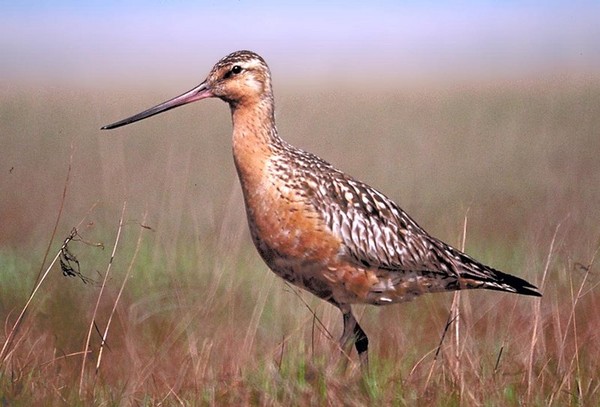Godwit E7 returns from Alaska, non-stop, to the Thames Mudflats
Monday 10 September 2007, 10:15PM
By NZPA
10,974 views
A bar-tailed godwit -- known to researchers as E7 -- is now back on her favourite mudflat on the Firth of Thames after a round trip of nearly 30,000km to Alaska and back.
E7 is the first godwit to have her full annual migration monitored by satellite. It included a southern return leg of more than 11,500km -- the longest non-stop flight by a bird to be recorded.
"From the speed that she was going, I'm absolutely confident that she came direct," said Massey ecologist Dr Phil Battley, who tagged 16 bar-tailed godwits to identify how they made their way to and from Alaska.
The south side of the Firth of Thames, near Miranda, was a muddy spot with difficult access, so it had not been possible to photograph the bird, which arrived l ate on Friday night.
Her transmitter switched itself on for six hours every 36 hours and on Friday afternoon she was south-west of Ninety Mile Beach in Northland. By 3am on Sunday morning she was back at Miranda where she is expected to stay " resting and refuelling" until about March, when she will make her way back to Alaska to lay eggs.
Dr Battley said E7 took off from the Yukon delta and could have shortened her journey by moving down to the Alaskan Peninsula to take off from about 500km further south.
"But she didn't do that," he said. "This indicates the long journey is not such a problem to her".
"It's quite amazing that even on a journey of 11,500km she's not trying to make it any shorter. She's got enough in reserve to cope.
Dr Battley is now awaiting the arrival of four other birds with transmitters still working.
Eight male birds fitted with backpack tracking devices have not been monitored because the devices appear to interfered with their flight or to have fallen off.
The transmitters on three of the eight birds, including E7, which had the devices surgically implanted also appear to have stopped working. Another female, tagged as Y3, spent the winter near Farewell Spit, and four others are still in Alaska.
Dr Battley's next project involves similar work with a sub-population of the bar-tailed godwit population in northwest Australia, allowing comparison of the migratory habits of the two populations.
The satellite track of the godwits' can be viewed online at: http://alaska.usgs.gov/science/biology/shorebirds/barg-updates.html
